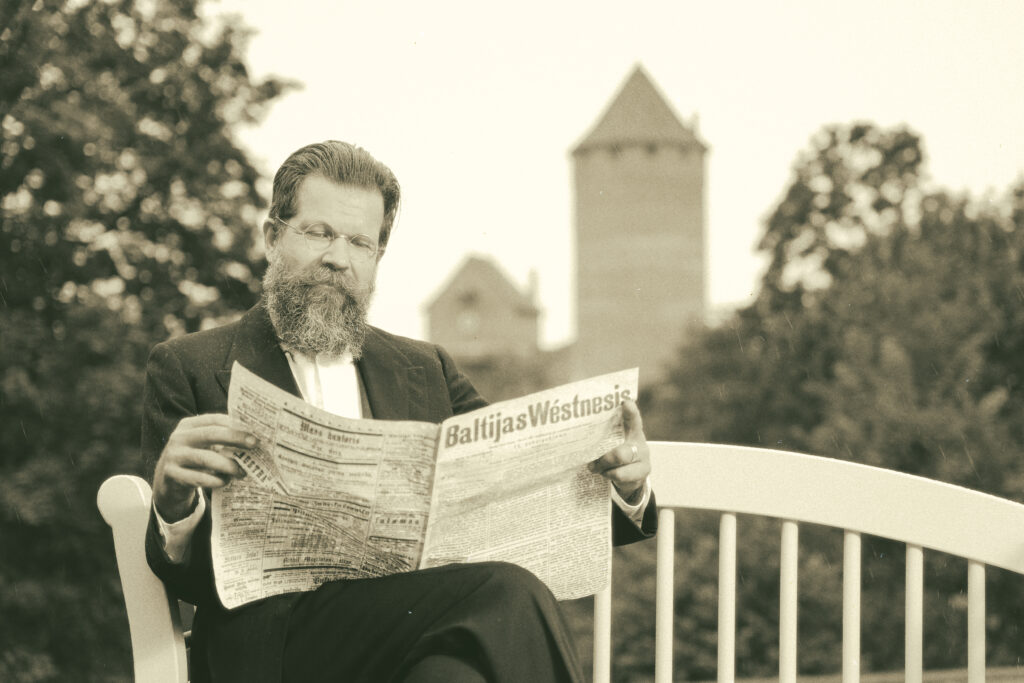Inviting everyone to remember the folklore researcher Krišjānis Barons and draw inspiration from his achievements, long life and endurance, several events will be organized in October:
11 October, 1:00 p.m.–2:30 p.m.
A Walk on Folk Song Hill – “The uniqueness of Folk Song Hill and Indulis Ojārs Ranka’s sculptures in today’s perspective”. A conversation between Arta Vārpa, Art Historian, Curator of the LNAM Sculpture and Object Collection, and Ilze Egle, Artist and daughter of sculptor Indulis Ojārs Ranka.
October 18, 10:00 a.m. – 6:00 p.m.
A Hike of Krišjānis Barons with tasks in cooperation with the Ziedonis Museum. Route: Sigulda, a monument to K. Barons – homestead “Dainas” – a clean up on Krišjānis Barons trail, organized in cooperation with the Nature Conservation Agency. The hike will conclude on Folk Song Hill with a performance of the traditional singing group “Saucējas” and folklorist Aiga Auziņa.
October 31 at 10:00 a.m.
A morning with folk songs. Krišjānis Barons – 190. At the Krišjānis Barons monument in Sigulda. Everyone is invited to share their favorite folk song throughout the day.
In October, school-age students and those who are interested will be offered a new interactive programme at Folk Song Hill, where participants will discover the world of folk songs and learn more about the sculptures created by Indulis Ranka on Folk Song Hill when searching for marks and solving tasks.
The programme was created by the Turaida Museum Reserve in collabortion with the representatives of Ziedonis’ class
The Turaida Museum Reserve, in collaboration with the Sigulda County Council, the Ziedonis Museum, the Nature Conservation Agency, and the K. Barons homestead “Dainas” invites everyone to celebrate the 190th birthday of folklore researcher, linguist, public figure, and teacher Krišjānis Barons with a variety of events in October.
Krišjānis Barons (1835-1923) is best known to the general public for his work of compiling, systematizing, and publishing Latvian folk songs in the collection “Latvju dainas”.
However, his interests and contribution to the education of the Latvian people were much broader. He was a linguist and translator, and was involved in introducing foreign words, for example, in mathematics, geography, physics, and biology.
One of the representatives of the movement – the New Latvians, founder of the newspaper “Pēterburgas avīzes” (St. Petersburg Newspaper). He published the latest scientific findings of his time, was interested in mathematics, astronomy, geography, etc., and prepared and published several popular educational works, such as the bibliographic index “Reflections on the Indigenous Peoples of the Baltic Region” and others.
He published poems and stories, but his book “A Description of Our Homeland”, published in 1859, is unique in that it contains two 19th-century accounts of the Latvian land and people in a single volume.
The book was published to educate the Latvian people about the land they live in, about other peoples who inhabit our land, as well as about the value and antiquity of the native Latvian language among the languages of the world.
Krišjānis Barons in Turaida
Krišjānis Barons spent the last summer of his life, in 1922, at the homestead “Dainas” in Turaida. His daughter-in-law Līna Barone wrote about this period in a memoir: “After breakfast, if the weather was sunny outside, my father went out for a walk and disappear for several hours.
He was always carrying a walking stick made of juniper in one hand and a collapsible little chair in the other. Thus he hiked accross the hills and hillocks of the area..
There was once a young man who was climbing up the steep trail of the Turaida Hill and when he got to the top, he was weary and sat down for a rest. Then he spotted a white-haired little old man climbing the same trail – climbing and climbing until he reached the top.
He did not sit down. Instead, he walked past the young man to the edge of the hill, from which a lovely view of the Gauja valley can be found. He looked at the vista for a while, and then slowly walked away.
It didn’t seem at all that the little old man was weary, and only then the young man realise that it was Father Barons. He was delighted at the old man’s durability and flexibility at such a great age.”
Foto: Edgars Semanis

